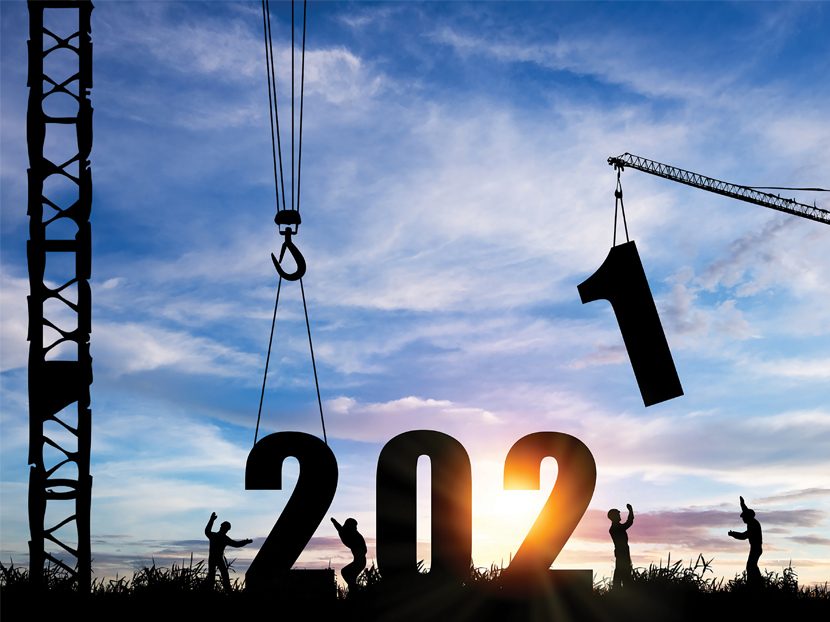Plumbing, HVACR Bright Spots in 2021
Even as U.S. COVID-19 cases rise, there’s little reason to expect a decline in renovation/replacement demand, which exceeded 2020 expectations.

As 2020 (mercifully) draws to a close and our industry considers what lies ahead, businesses would be wise to study the events of last year to better understand how 2021 might unfold. Early in 2020, when COVID-19 turned the world on its head and necessitated widespread lockdowns to “flatten the curve,” few analysts saw an opportunity for the HVACR/plumbing industry to have a strong year.
You might recall predictions of 30 percent unemployment and an economic catastrophe that would rival or exceed the Great Depression — predictions that for a while seemed to have merit. During the spring, U.S. unemployment reached an 80-year high (14.7 percent), more than 20 million people lost their jobs, consumer sentiment experienced its largest one-month drop in history, manufacturing output experienced its largest one-month decline in 74 years, and so on.
Yet when spring turned to summer and the lockdowns began to end, demand for plumbing and HVACR services surged. Figure 1 tells the story better: it shows monthly hardware, plumbing and heating equipment distributor sales.

From peak to trough, the volume of distributor sales declined 15 percent in 2020. By way of comparison, total sales volume declined by 23 percent during the Great Recession — except that happened over 18 months, not in the 2-month span we witnessed last year. Equally astounding is the recovery, where sales jumped by 24 percent from their April low to July peak. Coming out of the Great Recession, it took 32 months(!) for distributor sales volume to recover by a similar 24 percent margin.
How is it possible that demand could rebound to the extent it did in 2020 when unemployment rates exceeded the highest levels of any recession since the Great Depression?
Reason 1:
Stimulus, Enhanced Unemployment Benefits Propped Up Consumer Spending
The information in Figure 2 shows the change in consumer spending levels throughout 2020, relative to its pre-COVID levels. (For more information on Opportunity Insights’ methodology, visit https://bit.ly/3gpMuCJ.)
The graph shows a clear bounce in consumer spending levels following the passage of the CARES Act and the issuance of stimulus payments. This supports the idea that stimulus and enhanced unemployment benefits supported spending levels when unemployment was spiking. Purchases of durable goods in particular, which includes plumbing and HVACR products, surged after stimulus payments were made.

Reason 2:
Homeowners Insulated from Worst Effects of COVID Recession
While the passage of the CARES Act and the issuance of stimulus checks had a clear positive impact on consumer spending, our industry appears to have benefited most from the unique way COVID-19 has affected the economy.
According to data from Opportunity Insights (Figure 3), throughout the COVID crisis, unemployment has been most concentrated among workers making less than $27,000 annually. In comparison, employment rates among workers making more than $60,000 had almost entirely returned to their pre-COVID levels by June.

Why are the income levels of unemployed Americans relevant here? According to data from the U.S. Census Bureau, most U.S. homes are owned by households making more than $75,000 annually. Although the income bands from the Census Bureau and Opportunity Insights don’t perfectly align, it seems reasonable to assume that individuals making more than $60,000 annually likely belong to households with greater than $75,000 in total income. This means renovation/replacement demand should have remained stable despite the economic turmoil.
However, in a positive twist, renovation/replacement demand exceeded expectations. Through August, HARDI estimates that add-on replacement shipments of air conditioning and air-source heat pump equipment were 2.5 percent higher than at the same point in 2019 (Figure 4).

Likewise, the Leading Indicator of Remodeling Activity — a useful metric for evaluating the broader renovation/replacement market — showed steady growth in the second and third quarters of 2020. The report from the Joint Center for Housing Studies of Harvard University is projecting continued strength in the remodeling market through next year (Figure 5).

The unexpected strength of the renovation/replacement market can likely be credited to the increased time most homeowners spent at home last year. For most households with income exceeding $75,000, the U.S. Census Bureau reports that at least one member of the family has been able to work from home throughout the COVID crisis (Figure 6). No doubt the work-from-home model buoys the renovation/replacement market as people look to put their extra time at home to good use.

What’s Next?
With COVID-19 cases climbing around the country, it appears unlikely that current work-from-home trends will be changing any time soon. Consequently, there’s little reason to expect a decline in demand for residential renovation/replacement services. While ServiceTitan notes weaker contractor demand in the Midwest as COVID cases spike, future jobs reported nationally remain well above 2019 levels — a trend that has been observable since early May (Figure 7).

Fear of COVID-19 and the looming prospect of additional stay-at-home orders could certainly weaken demand for residential renovation and replacement services. But from this vantage point, a significant decline in demand seems unlikely.
As a result, contractors and distributors alike should consider taking strong inventory positions to ensure they can meet demand and guard against the possibility of continued product shortages. Many manufacturers are still playing catch up after production disruptions this spring, and total production capacity will remain limited as long as COVID-19 safety protocols remain in place.
On a macro level, the economic outlook is mixed. COVID-19 will be a drag on the economy until its threat is eliminated, and as such total economic output appears unlikely to return to its pre-COVID levels until 2022. However, just as in 2020, certain industries will outperform the broader economy in 2021 — and the HVACR/plumbing industry is poised to be one of those bright spots.




